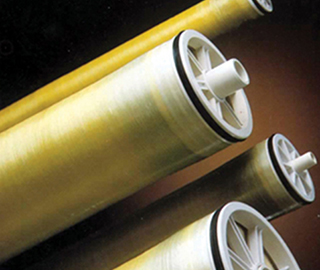Brief introduction of reverse osmosis membrane1
Issuing time:2019-10-18 13:37 Reverse osmosis technology is a kind of technology which can remove other substances and water from the semi permeable membrane when it is higher than the osmotic pressure of solution. The core element of this technology is reverse osmosis membrane. Reverse osmosis membrane is a kind of artificial semipermeable membrane with certain characteristics, which is made of cellulose acetate membrane, aromatic polyhydrazide membrane, aromatic polyamide membrane and other polymer materials. The pore size of this kind of membrane is very small, the diameter is generally between 0.5-10nm, so it can remove dissolved salts, microorganisms, organics and colloids in water very effectively. The RO system has the advantages of good water quality, low energy consumption, no pollution, simple process and convenient operation. The permeability of the reverse osmosis membrane is related to the chemical structure of the membrane itself. For example, some polymer materials have good rejection to salt, but the water penetration rate is not good; some polymer materials have more hydrophilic groups, so the water penetration rate is relatively fast. Therefore, a satisfactory reverse osmosis membrane should have the appropriate permeability and desalination rate. To sum up, the reverse osmosis membrane should have the following characteristics: (1) it should have high efficiency desalination rate at high flow rate; (2) high mechanical strength and service life; (3) be able to function under low operating pressure; (4) be able to withstand the influence of chemical or biochemical action; (5) it is less affected by pH value, temperature and other factors. (6) the raw materials for membrane preparation are easy to source, simple to process and low in cost. The structure of reverse osmosis membrane includes asymmetric membrane and homogeneous membrane. At present, cellulose acetate and aromatic polyamide are the main membrane materials. Its components are hollow fiber type, roll type, plate frame type and tube type. It can be used in separation, concentration, purification and other chemical unit operations, mainly used in pure water preparation and water treatment industry. Working principle of reverse osmosis: reverse osmosis is also known as reverse osmosis, which is a way of membrane separation operation with pressure difference as driving force to separate solvent from solution. The specific operation is to apply pressure to the feed liquid at one side of the membrane. When the pressure exceeds its osmotic pressure, the solvent will reverse osmosis in the direction of natural penetration, so as to obtain the penetrating solvent at the low pressure side of the membrane, i.e. the osmotic solution; and the concentrated solution, i.e. the concentrated solution, at the high pressure side. If the seawater is treated by reverse osmosis, fresh water is obtained at the low pressure side of the membrane, and brine is obtained at the high pressure side. In reverse osmosis, the penetration rate of solvent, i.e. liquid flow energy N, is: n = KH (Δ p - Δπ), in which KH is the hydraulic permeability coefficient, which increases slightly with the increase of temperature; Δ P is the static pressure difference on both sides of the membrane; Δπ is the osmotic pressure difference of the solution on both sides of the membrane. The osmotic pressure π of dilute solution is: π = the number of ions produced by ionization of solute molecules in ICRT formula; C is the molar concentration of solute; R is the molar gas constant; t is the absolute temperature. Asymmetric membrane and composite membrane are usually used in reverse osmosis. Reverse osmosis equipment, mainly hollow fiber or roll type membrane separation equipment. The reverse osmosis membrane can intercept all kinds of inorganic ions, colloidal substances and macromolecular solutes in water, so as to obtain purified water. It can also be used for preconcentration of macromolecular organic solution. Because of its simple process and low energy consumption, reverse osmosis has developed rapidly in recent 20 years. It has been widely used in desalination of seawater and brackish water (see brine), softening of boiler water and wastewater treatment, and combined with ion exchange to produce high-purity water. Its application scope is expanding, and it has been used in the concentration of dairy products and fruit juice, as well as the separation and concentration of biochemical and biological preparations. The reverse osmosis membrane can intercept substances larger than 0.0001 μ m, which is the most refined membrane separation product. It can effectively intercept all dissolved salts and organics with molecular weight greater than 100, and allow water molecules to pass through.
|


